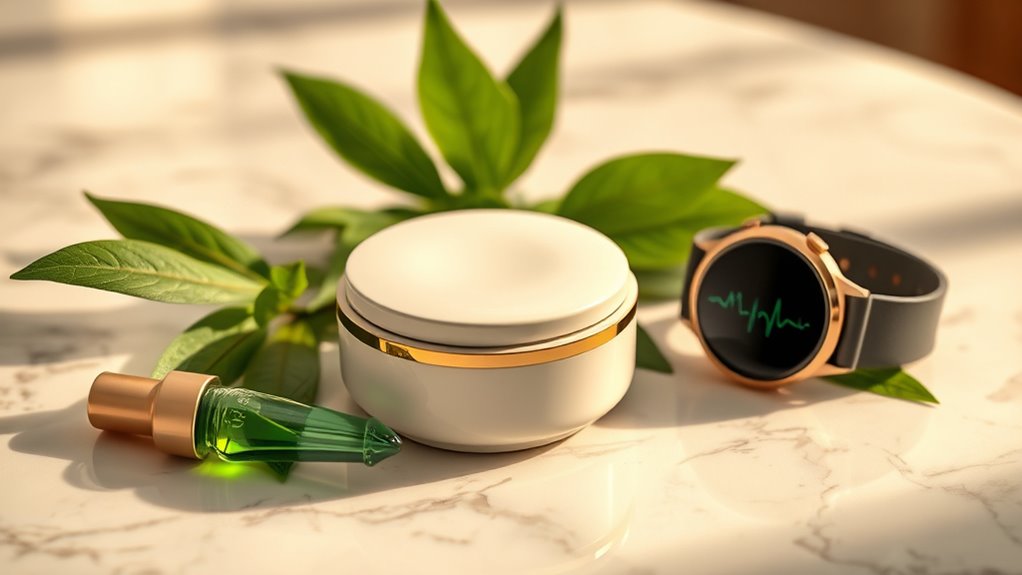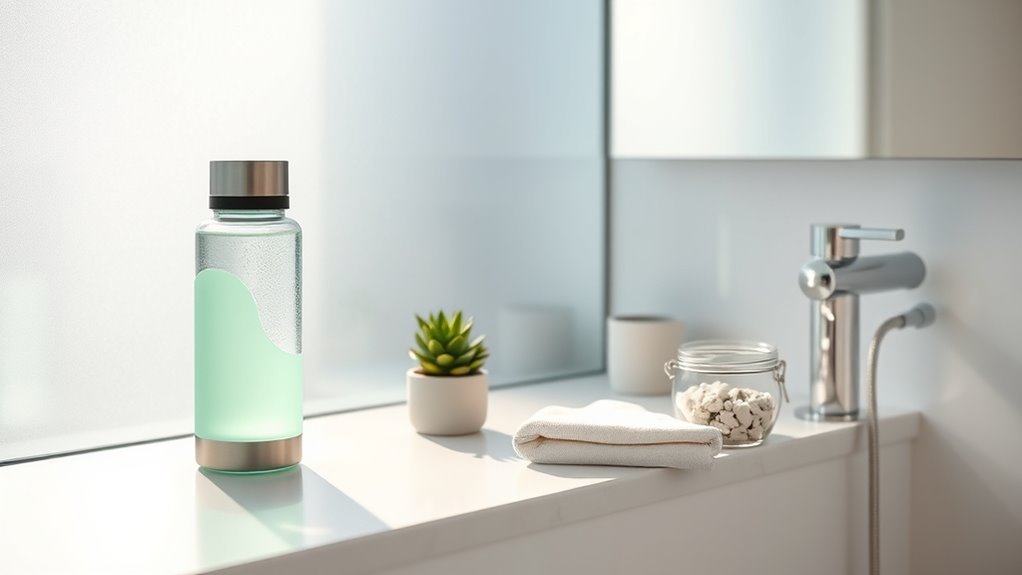To visualize wellness as a luxury, focus on minimalist, refined designs that evoke calm, balance, and exclusivity. Use soft, natural tones, high-quality textures, and smooth finishes to convey sophistication. Incorporate digital elements and premium materials to enhance perceived value and create a seamless, luxurious experience. By emphasizing quality and elegance, you position health as a self-indulgent lifestyle choice. Continue exploring to discover how design choices can elevate wellness products into desirable, aspirational items.
Key Takeaways
- Use minimalist aesthetics, soft tones, and high-quality finishes to evoke sophistication and a sense of indulgent wellness.
- Incorporate luxurious textures and materials that convey exclusivity and elevate perceived product value.
- Design visual cues that emphasize calmness, balance, and refinement, aligning wellness with premium lifestyles.
- Integrate digital elements securely and innovatively to enhance user experience and reinforce exclusivity.
- Position wellness products as self-care symbols, emphasizing quality and refinement to appeal to aspirational consumers.

Have you ever considered that good health has become a luxury in today’s society? It’s a sobering thought, but as modern life gets busier and more stressful, maintaining wellness often feels out of reach for many. Instead of being a simple, accessible part of life, health now appears as something exclusive—reserved for those who can afford premium wellbeing products and lifestyles. This shift influences how we design products, especially when it comes to promoting mindful living. When wellness is viewed as a luxury, product design needs to reflect a sense of sophistication, quality, and exclusivity. It’s about creating experiences that don’t just support health but elevate it to a status symbol.
In this context, visualizing wellness in product design isn’t just about functionality; it’s about evoking a sense of calm, balance, and refinement. Think of sleek, minimalist aesthetics that communicate clarity and serenity. The colors, textures, and materials should evoke a feeling of luxury—soft, natural tones, smooth finishes, and high-quality craftsmanship. This approach appeals to consumers seeking more than just basic health benefits; they want an experience that aligns with their desire for premium wellbeing. Every detail should reinforce the idea that investing in health is a form of self-care worth indulging in. Additionally, considering the risks and rewards of Bitcoin IRAs can inspire innovative ways to integrate secure, high-quality materials and digital features that elevate wellness products.
Frequently Asked Questions
How Can Product Design Influence Perceptions of Health as a Luxury?
You can influence perceptions of health as a luxury through thoughtful product design by ensuring branding consistency that exudes sophistication and exclusivity. Incorporate sensory engagement by using high-quality materials, appealing textures, and calming visuals to create a luxurious experience. When your design evokes elegance and mindfulness, it elevates wellness into a premium lifestyle, making consumers see health as a desirable and upscale choice.
What Are the Key Visual Elements That Convey Wellness in Product Design?
You can convey wellness through product design by utilizing calming color psychology, such as soft blues and greens, which promote relaxation and balance. Embrace minimalistic aesthetics to create a clean, uncluttered look that emphasizes purity and simplicity. These visual elements work together to evoke a sense of tranquility and health, making the product feel like a luxurious, mindful choice that enhances your well-being.
How Do Cultural Differences Impact Luxury Wellness Product Aesthetics?
You’ll find that cultural symbolism and aesthetic preferences greatly influence luxury wellness product aesthetics. Different cultures prioritize specific symbols, colors, and materials that evoke wellness and luxury uniquely. For example, some cultures favor minimalist designs, while others embrace intricate patterns. By understanding these cultural nuances, you can create products that resonate deeply with diverse audiences, enhancing perceived value and authenticity in your wellness offerings.
What Materials Best Symbolize Health and Luxury in Design?
Ironically, you’ll find that natural textures like soft bamboo, smooth marble, and warm cork best symbolize health and luxury. These materials evoke purity and sophistication, perfectly aligning with minimalist elegance. Their tactile appeal and understated beauty suggest wellness without shouting for attention. Incorporate these natural elements into your designs to create a sense of calm and exclusivity, making consumers feel indulgently healthy and effortlessly elegant at the same time.
How Can Sustainable Practices Enhance the Luxury Wellness Experience?
You can enhance the luxury wellness experience by prioritizing sustainable practices like eco-friendly packaging and ethical sourcing. These choices not only reduce environmental impact but also communicate your commitment to health and ethics, elevating your brand’s prestige. When customers see your dedication to sustainability, they feel more connected and valued, transforming wellness into an indulgent, responsible experience. Sustainable practices turn everyday products into symbols of luxury that align with conscious living.
Conclusion
Imagine a smartwatch that not only tracks your steps but also offers personalized wellness insights, turning health into a luxury experience. By designing products that emphasize both functionality and aesthetic appeal, you can make wellness feel exclusive and desirable. Just like a premium fitness app that integrates seamless design with expert guidance, your approach can elevate health to a status symbol. Embrace this mindset, and you’ll transform everyday products into symbols of well-being and sophistication.









